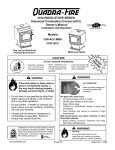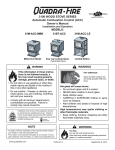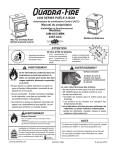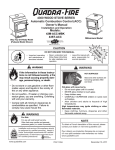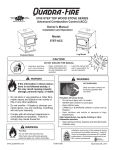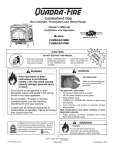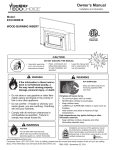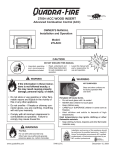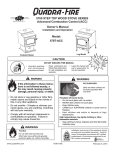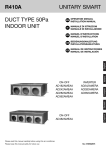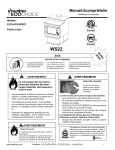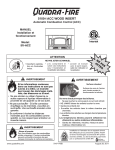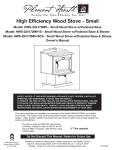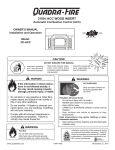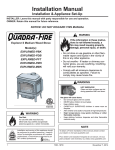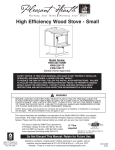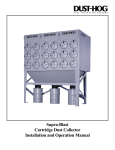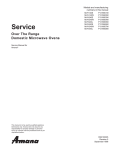Download Generac 004721-0, 004722-0, 004723-0, 004724-0, 004725-0, 004725-1, 004725-2, 004725-3, 004726
Transcript
R 3100 WOOD STOVE SERIES Advanced Combustion Control (ACC) Owner’s Manual Installation and Operation Models: 31M-ACC-MBK 31M-ACC-GT 31M-ACC-NT 31ST-ACC Beaverton Oregon USA Tested and Listed by US C OMNI- Test Laboratories, Inc. Step Top Uni-Body Model (Pedestal Model Shown) Millennium Model CAUTION DO NOT DISCARD THIS MANUAL • Important operating and maintenance instructions included. • Read, understand and follow these instructions for safe installation and operation. WARNING • Leave this manual with party responsible for use and operation. D DI O N SC O AR T D WARNING If the information in these instructions is not followed exactly, a fire may result causing property damage, personal injury, or death. HOT! DO NOT TOUCH. SEVERE BURNS MAY RESULT. CLOTHING IGNITION MAY RESULT. Glass and other surfaces are hot during operation and cool down. • Do not store or use gasoline or other flammable vapors and liquids in the vicinity of this or any other appliance. • Keep children away. • Do not overfire - If heater or chimney connector glows, you are overfiring. Overfiring will void your warranty. • Alert children and adults to hazards of high temperatures. • Comply with all minimum clearances to combustibles as specified. Failure to comply may cause house fire. • Do NOT operate with protective barriers removed or door open. • Keep clothing, furniture, draperies and other combustibles away. Installation and service of this appliance should be performed by qualified personnel. Hearth & Home Technologies recommends NFI certified professionals, or technicians supervised by an NFI certified professional. www.quadrafire.com • CAREFULLY SUPERVISE children in same room as appliance. 7033-277C WARNING Fire Risk. For use with solid wood fuel only. Other fuels may overfire and generate poisonous gases (i.e. carbon monoxide). March 2, 2007 R 3100 Wood Stove Series (ACC) and Welcome to the Hearth & Home Technologies welcomes you to our tradition of excellence! In choosing a Quadra-Fire appliance, you have our assurance of commitment to quality, durability, and performance. Quadra-Fire Family! meticulously fabricated and gold and nickel surfaces are hand-finished for lasting beauty and enjoyment. Our pledge to quality is completed as each model undergoes a quality control inspection. From design, to fabrication, to shipping: Our guarantee of quality is more than a word, it’s QuadraFire tradition, and we proudly back this tradition with a Limited Lifetime Warranty. This commitment begins with our research of the market, including ‘Voice of the Customer’ contacts, ensuring we make products that will satisfy your needs. Our Research and Development facility then employs the world’s most We wish you and your family many years of enjoyment in advanced technology to achieve the optimum operation the warmth and comfort of your hearth appliance. Thank of our stoves, inserts and fireplaces. And yet we are oldyou for choosing Quadra-Fire. fashioned when it comes to craftsmanship. Each unit is With warm regards, ___________________________ Alan Trusler t Senior Vice President Dealer Channel ___________________________ Dan Henry Vice President Advanced Technolgies _________________________ Jason Olmstead Vice President & General Manager ___________________________ Steve Tate Quadra-Fire Brand Manager SAMPLE OF SERIAL NUMBER / SAFETY LABEL LOCATION: BACK OF APPLIANCE Serial No. A S M P E L Model Name Test Lab & Report No. Mfg. Date Page 2 7033-277C March 2, 2007 R 3100 Wood Stove Series (ACC) TABLE OF CONTENTS Section 1: Listing and Code Approvals A. B. C. D. Section 8: Operating Instructions (Cont’d) Appliance Certifications ......................4 Mobile Home Approved ......................4 Glass Specifications ............................4 BTU & Efficiency Specifications ..........4 H. I. J. K. Section 2: Getting Started Blower Operating Instructions .............29 Opacity (Smoke) .................................29 Overfiring ............................................29 Frequently Asked Questions...............30 Section 9: Maintaining & Servicing Appliance A. Design, Installation & Location Considerations ....................................5 B. Fire Safety ..........................................5 C. Negative Pressure ..............................6 D. Flue Draft Considerations ...................7 E. Venting Systems .................................7 F. Tools and Supplies Needed................7 G. Inspect Appliance & Components.......7 H. Typical Stove System .........................8 A. B. C. D. E. F. General Maintenance & Cleaning .......31-32 Glass Replacement .............................32 Firebrick Replacement ........................33 Baffle Removal ....................................34 Snap Disc Replacement .....................34 Tube Channel Replacement ...............35 Section 10: Troubleshooting ........................36-37 Section 11: Reference Material Section 3: Dimensions & Clearances A. Appliance Dimensions ........................9-10 B. Clearances to Combustibles ...............11 Section 4: Installation Consideration A. Hearth Requirements .........................12-13 B. Outside Air ..........................................14 C. Blower Installation ...............................15 A. B. C. D. E. F. Exploded Drawings .............................38-40 Service Parts & Accessories...............41-43 Service & Maintenance Log ................44 Homeowner’s Notes ...........................45-46 Warranty Policy...................................47 Contact Information .............................48 Section 5: Chimney Requirements A. B. C. D. E. Venting Components ..........................16 Chimney Systems ...............................16-18 Installing Chimney Components .........18 Chimney Termination Requirements ..19 2-10-03 Rule ........................................19 Section 6: Mobile Home ...............................20 Section 7: Appliance Set-Up A. Pedestal & Ash Removal System (ARS) Installation ...............................21-22 B. Leg Kit & Ash Removal System (ARS) Installation...........................23 C. Door Handle Assembly .......................24 D. Blower Speed Adjustment ..................24 Section 8: Operating Instructions A. B. C. D. E. F. G. Fire Safety ...........................................25 Wood Selection & Storage ..................25 Burning Process ..................................25-26 Automatic Combustion Control (ACC) ....26 Air Controls .........................................26-27 Burn Rates & Operating Efficiency .....27 Building A Fire .....................................28 March 2, 2007 7033-277C Page 3 R 3100 Wood Stove Series (ACC) 1 Listing and Code Approvals D. BTU & Efficiency Specifications A. Appliance Certification Model: 3100 Millennium & Step Top (ACC) Uni-Body Laboratory: OMNI Test Laboratories, Inc. EPA Certified: Efficiency: BTU Output: Report No & Date: 061-S-66-6 Heating Capacity: Type: Wood Stove Standard: UL1482 and ULC S627 and (UM) 84-HUD, Mobile Home Approved. Vent Size: The Quadra-Fire 3100 Series Wood Stove (ACC) meets the U.S. Environmental Protection Agency’s 1990 particulate emission standards. Firebox Size: Max Wood Length: Fuel: Shipping Weight: 1.1 grams per hour 79.51% 11,800 to 32,000 up to1,800 sq ft 6 inches 2 cubic feet 18 inches Cord Wood 325 lbs B. Mobile Home Approved This appliance is approved for mobile home installations when not installed in a sleeping room and when an outside combustion air inlet is provided. The structural integrity of the mobile home floor, ceiling, and walls must be maintained. The appliance must be properly grounded to the frame of the mobile home and use only listed double-wall connector pipe. Outside Air Kit, part OAK-ACC must be installed in a mobile home installation NOTE: Hearth & Home Technologies, manufacturer of this appliance, reserves the right to alter its products, their specifications and/or price without notice. C. Glass Specifications This stove is equipped with 5mm ceramic glass. Replace glass only with 5mm ceramic glass. Please contact your dealer for replacement glass. NOTE: This installation must conform with local codes. In the absence of local codes you must comply with the UL1482, (UM) 84-HUD and NPFA211 in the U.S.A. and the ULC S627 and CAN/CSA-B365 Installation Codes in Canada. Page 4 7033-277C March 2, 2007 R 3100 Wood Stove Series (ACC) 2 Getting Started A. Design, Installation & Location Considerations B. Fire Safety Consideration must be given to: To provide reasonable fire safety, the following should be given serious consideration: • • • • Safety Convenience Traffic flow Chimney and chimney connector required It is a good idea to plan your installation on paper, using exact measurements for clearances and floor protection, before actually beginning the installation. If you are not using an existing chimney, place the appliance where there will be a clear passage for a factory-built listed chimney through the ceiling and roof. We recommend that a qualified building inspector and your insurance company representative review your plans before and after installation 1. Install at least one smoke detector on each floor of your home to ensure your safety. They should be located away from the heating appliance and close to the sleeping areas. Follow the smoke detector manufacturer’s placement and installation instructions, and be sure to maintain regularly. 2. A conveniently located Class A fire extinguisher to contend with small fires resulting from burning embers. 3. A practiced evacuation plan, consisting of at least two escape routes. 4. A plan to deal with a chimney fire as follows: If this appliance is in an area where children may be near it is recommended that you purchase a decorative barrier to go in front of the appliance. Remember to always keep children away while it is operating and do not let anyone operate this appliance unless they are familiar with these operating instructions. In the event of a chimney fire: a. b. c. d. Service / Maintenance Tip: In order to replace the tube channel a clearance of 19 inches (483mm) is required on the right side of stove in order to remove the tubes with the stove in place. If space is not available, the stove will have to be disconnected from the chimney to proceed with the tube replacement. See page 35. WARNING Fire Risk. • • • CAUTION Check building codes prior to installation. Notify fire department Prepare occupants for immediate evacuation. Close all openings into the stove. While awaiting fire department, watch for ignition of adjacent combustibles from overheated stove pipe, hot embers or sparks from the chimney. • Installation MUST comply with local, regional, state and national codes and regulations. • • Consult insurance carrier, local building, fire officials or authorities having jurisdiction about restrictions, installation inspection, and permits. • • • Hearth & Home Technologies disclaims any responsibility for, and the warranty will be voided by, the following actions: Installation and use of any damaged appliance. Modification of the appliance. Installation other than as instructed by Hearth & Home Technologies. Installation and/or use of any component part not approved by Hearth & Home Technologies. Operating appliance without fully assembling all components. Operating appliance without legs attached (if supplied with unit). Do NOT Overfire - If appliance or chimney connector glows, you are overfiring. Any such action that may cause a fire hazard. WARNING WARNING Asphyxiation Risk. • Do NOT connect this unit to a chimney flue servicing another appliance. • Do NOT connect to any air distribution duct or system. May allow flue gases to enter the house. March 2, 2007 7033-277C Fire Risk. • Do not operate appliance before reading and understanding operating instructions. • Failure to operate appliance properly may cause a house fire. Page 5 R 3100 Wood Stove Series (ACC) C. Negative Pressure Draft is the pressure difference needed to vent appliances successfully. Considerations for successful draft include: • Preventing negative pressure • Location of appliance and chimney Negative pressure results from the imbalance of air available for the stove to operate properly. Causes for this imbalance include: • Exhaust fans (kitchen, bath) etc.) • Range hoods • Combustion air requirements for furnaces, water heaters and other combustion appliances • Clothes dryers • Location of return-air vents to furnace or air conditioning • Imbalances of HVAC air handling system • Upper level air leaks • Recessed lighting • Attic hatch opening • Duct leaks To minimize the affects of negative air pressure the following must be considered: • Install the outside air kit. Install the intake on the side of the house towards prevailing winds during the heating season. • Ensure adequate outdoor air is supplied for combustion appliances and exhaust equipment. • Ensure furnace and air conditioning return vents are not located in the immediate vicinity of the appliance, • Avoid installing the appliance near doors, walkways or small isolated spaces. • Recessed lighting should be of “sealed can” design; attic hatches weather stripped or sealed; and attic mounted duckwork and air handler joints and seams taped or sealed. WARNING Asphyxiation Risk. • Negative pressure can cause spillage of combustion fumes, soot and carbon monoxide. • Appliance needs to draft properly for safety. Recommended Location Recommended Location Marginal Location Location Not Recommended Location NOT Recommended Windward Outside Termination Cap Leeward Multi-level Roofs Figure 6.1 Page 6 7033-277C March 2, 2007 R 3100 Wood Stove Series (ACC) D. Flue Draft Considerations F. Tools And Supplies Needed Location of the appliance and chimney will affect performance. As shown in Figure 6.1 on page 6 the chimney should: Before beginning the installation be sure that the following tools and building supplies are available. • Be installed through the warm space enclosed by the building envelope. This helps to produce more draft, especially during lighting and die down of the fire. • Penetrate the highest part of the roof. This minimizes the affects of wind turbulence and down drafts. • Consider the appliance location in order to avoid floor and ceiling attic joists and rafters. Exterior conditions such as roof line, surrounding trees, prevailing winds and nearby hills can influence stove performance. Your local dealer is the expert in your geographic area and can usually make suggestions or discover solutions that will easily correct your flue problem. To be sure that your appliance burns properly, the chimney draft (static pressure) should be approximately -.04 inch water column (W.C.) during a low burn and -.10 inch W.C. during a high burn, measured 6 inches (152mm) above the top of the appliance after one hour of operation at each burn setting. NOTE: These are guidelines only, and may vary somewhat for individual installations. E. Venting Systems The venting system consists of a chimney connector (also known as stove pipe) and a chimney. These get extremely hot during use. Temperatures inside the chimney may exceed 2000°F (1100°C) in the event of a creosote fire. To protect against the possibility of a house fire, the chimney connector and chimney must be properly installed and maintained. An approved thimble must be used when a connection is made through a combustible wall to a chimney. A chimney support package must be used when a connection is made through the ceiling to a prefabricated chimney. These accessories are absolutely necessary to provide safe clearances to combustible wall and ceiling material. Follow venting manufacturer’s clearances when installing venting system. Reciprocating saw Pliers Hammer Phillips Head Screwdriver Flat Blade Screwdriver Plumb Line Level Tape Measure Framing Material Hi-Temp Caulking Material Gloves Framing Square Electric Drill & Bits (1/4”) Safety Glasses 1/2 in. - 3/4 in. length, #6 or #8 self drilling screws (need 3 per pipe section connection) G. Inspect Appliance & Components and Pre-Use Check List 1. Place the appliance in a location near the final installation area and follow the procedures below: 2. Open the appliance and remove all the parts and articles packed inside the Component Pack. Inspect all the parts and glass for shipping damage. Contact your dealer if any irregularities are noticed. 3. All safety warnings have been read and followed. 4. This Owner’s Manual has been read. 5. Floor protection requirements have been met. 6. Venting is properly installed. 7. The proper clearances from the appliance and chimney to combustible materials have been met. 8. The masonry chimney is inspected by a professional and is clean, or the factory built metal chimney is installed according to the manufacturer’s instructions and clearances. 9. The chimney meets the required minimum height. 10. All labels have been removed from the glass door. 11. Plated surfaces have been wiped clean, if applicable. 12. A power outlet is available nearby if installing optional blower assembly. WARNING WARNING Fire Risk. Inspect appliance and components for damage. Damaged parts may impair safe operation. Asphyxiation Risk. • Do NOT connect this unit to a chimney flue servicing another appliance. • Do NOT connect to any air distributon duct or system. May allow flue gases to enter the house. • Do NOT install damaged components. • Do NOT install incomplete components. • Do NOT install substitute components. Report damaged parts to dealer. March 2, 2007 7033-277C Page 7 R 3100 Wood Stove Series (ACC) Spark Arrestor Cap H. Typical Stove Systems Fireclay Flue Liner With Air Space Concrete Cap Stove system with masonry chimney consists of: Rafter • Stove Flashing • Chimney Connector (stove pipe) 1" (25mm) Clearance With Firestop • Thimble Ceiling Joist • Masonry Chimney • Hearth Pad Floor Protection Eave Combustible Wall Thimble, 12" (305mm) Of Brick Sheathing Outside Air Rear Vent Outside Air Termination Cap Floor Protector Airtight Cleanout Door Figure 8.1 Masonry Chimney Stove system with prefabricated metal chimney consists of: • Stove • Chimney Connector (stove pipe) Listed Termination Cap Storm Collar Listed Termination Cap Flashing Roof Brace (if required) • Thimble (for exterior chimney) Storm Collar Flashing Listed Chimney • Firestops • Insulations Shields • Storm Collar and Flashing • Termination Cap • Hearth Pad Floor Protection Trim Collar on Inside Wall Listed Chimney Insulated " T " Chimney Connector Wall Support Ceiling Support Chimney Connector Floor Protector Floor Protector Figure 8.2 Exterior Prefabricated Chimney Page 8 7033-277C Figure 8.3 Interior Prefabricated Chimney March 2, 2007 R 3100 Wood Stove Series (ACC) 3 Dimensions and Clearances 25 in. (635mm) A. Appliance Dimensions 9-15/16 in. (237mm) NOTE: Flue Collar size is 6 inch (152mm) diameter (ID) CL 12-1/2 in. (318mm) 10-15/16 in. 15-1/16 in. (271mm) (383mm) Millennium Model 14-15/16 in. (373mm) 18-15/16 in. (475mm) 30 in. (762mm) Figure 9.1 Front View 26-11/16 in. (668mm) 24-5/16 in. (618mm) 6-11/16 in. (170mm) CL 16 in. (406mm) 11-1/2 in. (292mm) 20-3/4 in. (527mm) Figure 9.2 Side View March 2, 2007 7033-277C Page 9 R 3100 Wood Stove Series (ACC) Appliance Dimensions (Cont’d) 3100 Step Top Pedestal Model 3100 Step Top Leg Model 25 in. (635mm) 9-5/16 in. (237mm) CL 12-1/2 in. (318mm) 14-15/16 in. (379mm) 19-1/16 in. (484mm) 15-1/16 in. (383mm) 33-1/8 in. (841mm) 10-15/16 in. (278mm) 34-1/4 in. (870mm) 18 in. (457mm) 23-7/8 in. (606mm) Figure 10.1 Figure 10.3 26-11/16 in.(678mm) 6-11/16 in. (170mm) 24-5/16 in. (618mm) 15-3/8 in. (391mm) CL 3-11/16 in. (94mm) 3-1/2 in. (89mm) Back of Stove to Glass 23-3/8 in. (594mm) 16 in. (406mm) 10-3/8 in. (264mm) 11-1/2 in. (292mm) 21-1/8 in. (537mm) 20-3/4 in. (527mm) Figure 10.2 Page 10 Figure 10.4 7033-277C March 2, 2007 R 3100 Wood Stove Series (ACC) B. Clearances to Combustibles (UL and ULC) BACKWALL / SIDEWALL A ALCOVE SIDE VIEW NOTE: Clearances may only be reduced by means approved by the regulatory authority having jurisdiction B G C D 90° OFF TOP UP & OUT CEILING CLEARANCE H A * B G STOVE TO CEILING CLEARANCE CORNER INSTALLATION ALCOVE TOP VIEW E F C E D F MINIMUM CLEARANCES TO COMBUSTIBLE MATERIALS In Inches & (Millimeters) NOTE: All "A" , "C" and "F" Dimensions are to the inside diameter of the flue collar. A B C D E INSTALLATION: Full Vertical OR Horizontal with Minimum 2 FT Vertical Off Stove Top SINGLE WALL PIPE Flat Top Model Step-Top Model 15.25 (387) 11.75 (298) 25.5 (648) 12 (305) 8.5 (216) 22 (559) DOUBLE WALL PIPE Flat Top Model Step-Top Model 10.5 (267) 10 (228) 6.5 (165) 6 (152) 22 (559) 20.5 (521) F G H 16 (406) 12.5 (318) 8 (203) 5.5 (140 17 (432) 14.5 (368) 48 (1220) 48 (1220) 12 (305) 12 (305) 13 (330) 11 (279) 6.5 (165) 4 (102) 15.5 (394) 13 (330) 48 (1220) 48 (1220) 9 (229) 9 (229) INSTALLATION: 90° Elbow Off Top of Stove Through Backwall SINGLE WALL PIPE Flat Top Model Step-Top Model 12 (305) 10 (254) 8.5 (216) 6 (152) 22 (559) 20.5 (521) 13 (330) 11 (279) 8 (203) 5.5 (140) 17 (432) 14.5 (368) 48 (1220) 48 (1220) 12 (305) 12 (305) DOUBLE WALL PIPE Flat Top Model Step-Top Model 8 (203) 10 (254) 4.5 (114) 6 (152) 17.5 (445) 20.5 (521) 8.5 (216) 11 (279) 6.5 (165) 4 (102) 15.5 (394) 13 (330) 48 (1220) 48 (1220) 9 (229) 9 (229) INSTALLATION: ALCOVE Six inch (6") (152mm) diameter listed Double Wall air insulated connector pipe with UL103 HT* listed factory-built Class "A" chimney, or a masonry chimney. (Mobile Home must be equipped with a spark arrestor). Maximum depth of Alcove shall be no more than 48 inches (1220mm) with a minimum height of 48 inches (1220mm) to top of unit, and the referenced clearances. *In Canada must comply with CAN/ULC-S269 M87 for the 650oC Factory-built chimney. DOUBLE WALL PIPE Flat Top Model Step-Top Model 11.75 (298) 8.25 (210) 10 (254) 6.5 (152) 23.5 (597) 14.5 (368) 20.5 (521) 11 (279) N/A N/A N/A N/A 48 (1220) 48 (1220) * * * SEE PIPE MANUFACTURERS CLEARANCES - NOT TESTED SERVICE / MAINTENANCE TIP WARNING Fire Risk. • Comply with all minimum clearances to combustibles as specified. • Failure to comply may cause house fire. March 2, 2007 In order to replace the tube channel assembly a clearance of 19 inches (483mm) is required on the right side of stove in order to remove the tubes with the stove in place. If space is not available, the stove will have to be disconnected from the chimney to proceed with the tube replacement. 7033-277C Page 11 R 3100 Wood Stove Series (ACC) 4 Installation A. Hearth Protection Requirements FLOOR PROTECTION: Floor protector must be non-combustible material, extending beneath heater and to the front, sides and rear as indicated. The floor must be non-combustible or otherwise adequately protected from radiant heat given off by the unit and from sparks and falling embers. A layer of thin brick or ceramic tile over a combustible floor is not sufficient. In Canada, similar floor protection must be provided 18 inches (457mm) in front and 8 inches (203mm) from the sides and rear of the stove. *See exception. *EXCEPTION: Non-combustible floor protections must extend beneath the flue pipe when installed with horizontal venting and extend 2 inches (51mm) beyond each side. See Figure 12.4. WARNING For the Millennium Model In US installations, it is necessary to install a floor protector of a minimum of 3/8 inch (9.5mm) thick metal clad millboard or equivalent a minimum of 16 inches (406mm) in front of glass and 8 inches (203mm) to both sides of the fuel loading door. Open the door and measure 8 inches (203mm) from the side edge of the opening in the face of the appliance. *See exception. Fire Risk. • Hearth pads must be installed exactly as specified. High temperatures or hot embers may ignite concealed combustibles. Millennium Model 49-7/8 in. /8 in . lc -5 na ge 27-5/8 in. 31 o io pt ra o co ptio ve na ra l ge e ov 3-1/8 in." 39-5/8 in. minimum 11 -3 /8 ra co -7 /8 in . qu i re d in re -5 /8 15 USA 39 o co ptio ve na ra l ge . 8 in. 16" from glass ge in . in . 49-7/8 in. 16 Fuel loading door ve 4-7/8 in. 31-5/8 in. minimum 27-5/8 in. Figure 12.1 USA Figure 12.3 USA required Canada recommended 203mm (8 in.) 203mm (8 in.) 203mm (8 in.) 1260mm (49-5/8 in.) minimum 457mm (18 in.) CANADA Must extend 2 in. (51mm) beyond each side of pipe (shaded area) 1041mm (41 in.) minimum Figure 12.2 Page 12 Figure 12.4 7033-277C March 2, 2007 R 3100 Wood Stove Series (ACC) Step-Top Uni-Body Model For the Step Top Pedestal Model In US installations, it is necessary to install a floor protector of a minimum of 3/8 inch (9.5mm) thick metal clad millboard or equivalent a minimum of 16 inches (406mm) in front of glass and 8 inches (203mm) to both sides of the fuel loading door. Open the door and measure 8 inches (203mm) from the side edge of the opening in the face of the appliance. *See page 12 for Canadian clearances and horizontal venting exception. For the Step Top Leg Model In US installations, it is necessary to install a floor protector of a minimum thickness of 1-1/4 inch (32mm) or 1/2 inch of “k” value of 0.84 thick metal clad millboard or equivalent a minimum of 16 inches (406mm) in front of glass and 8 inches (203mm) to both sides of the fuel loading door. Open the door and measure 8 inches (203mm) from the side edge of the opening in the face of the appliance. *See page 12 for Canadian clearances and horizontal venting exception. 49-7/8 in. 3-1/4 in. 4-3/4 in. /8 in . lc -5 na ge 27-5/8 in. 31 tio op ra o co ptio ve na ra l ge e ov 39-5/8 in. minimum Fuel loading door 3/ 8 ge ra 11 - ve i re -7 /8 in . qu 15 31-5/8 in. minimum re -5 /8 39 USA d in . co 8 in. o co ptio ve na ra l ge 16 in. from glass 16 in . in . 49-7/8 in. 27-5/8 in. Figure 13.1 USA Figure 13.3 USA required Canada recommended 203mm (8 in.) 203mm (8 in.) 203mm (8 in.) 1254mm (49-3/8 in.) minimum 457mm (18 in.) CANADA Must extend 2 in. (51mm) beyond each side of pipe (shaded area) 1041mm (41 in.) minimum Figure 13.4 Figure 13.2 NOTE: • March 2, 2007 Illustrations and photos reflect typical installations and are FOR DESIGN PURPOSES ONLY. • Illustrations/diagrams are not drawn to scale. • Actual installation may vary due to individual design preference • Hearth & Home Technologies reserves the right to alter its products. 7033-277C Page 13 R 3100 Wood Stove Series (ACC) B. Outside Air Kit Installation WARNING A source of air (oxygen) is necessary in order for combustion to take place. Whatever combustion air is consumed by the fire must be replaced. Air is replaced via air leakage around windows and under doors. In homes that have tightly sealed doors and windows, an outside air source is needed. An optional Outside Air Kit is available. Fire Risk. Asphyxiation Risk. Do not draw outside combustion air from: Included in OAK-ACC: Termination cap, (2) wire ties, flex adapter, and fasteners • Wall, floor or ceiling cavity • Enclosed space such as an attic or garage • Close proximity to exhaust vents or chimneys Fumes or odor may result Included in SRV7033-041: Cover plate and sealing rope (see Floor Installation Alternative below, Figure 14.2) WARNING Asphyxiation Risk. Items Needed for Installation (not supplied) Outside air inlet must be located to prevent blockage from: • 4 inch flex aluminum pipe, or if using alternate material, then it shall be made from durable, non-combustible, heat resistant material up to 350oF. Cut the pipe to the required length for your installation. • Phillips head screw driver • Silicone sealant • Drills and saws necessary for cutting holes through the wall or flooring in your home. • Leaves • Snow or ice • Other debris Block may cause combustion air starvation Smoke spillage may set off alarms or irritate sensitive individuals. WARNING 1. Remove all materials from packing box. Asphyxiation Risk. Length of outside air supply duct shall NOT exceed the length of the vertical height of the exhaust flue. • Fire will not burn properly • Smoke spillage occurs when door is opened due to air starvation. 2. Using a #2 Phillips screw driver attach the flex adapter to the stove using 4 screws. Figure 14.1 3. Remove circular” knock-out” in the base of the pedestal. 4. Floor & Rear Installation: Cut a 4 inch (102mm) hole in outside wall or floor to accommodate outside air piping. Use 4 inch (102mm) aluminum metal flex or rigid piping to directly connect outside air to appliance intake. Use the supplied termination cap with a rodent screen. Seal between the wall (or floor) and the pipe with silicone to prevent moisture penetration. 5. Floor Installation Alternative: In some instances you may not be able to install the flex pipe as show in Figure 14.1. If that is the case, you will need to order SRV7033041 which includes a cover plate and sealing rope as shown in Figure 14.2. The goal is to seal the pedestal so no room air can leak into the pedestal. Flex Adapter Wire Tie Terminatio Cap Rope to Seal Pedestal Cover Plate Remove circular “knock-out” in base of pedestal. Flex Line Wire Tie Figure 14.2 - Floor Installation Alternative Figure 14.1 - Floor & Rear Installation Page 14 7033-277C March 2, 2007 Do not remove. R 3100 Wood Stove Series (ACC) C. Blower (Optional) CAUTION 1. Remove the 3 bolts (1/4”-20 Phillips head) on the outer skin at the bottom rear of appliance. Shock Risk. • Do NOT remove grounding prong from plug. • Plug directly into properly grounded 3 prong receptacle. • Route cord away from appliance. • Do NOT route cord under or in front of appliance. 2. Align holes in mounting flange of blower with bolt holes in appliance. Blower should be positioned at bottom of rear outer skin as shown in Figure 15.1. 3. Re-insert and tighten bolts, securing blower onto outer wall of appliance. 4. Place the bracket containing the snap disc and magnet under the bottom left rear corner as shown in Figure 15.1. See page 29 for detailed operating instructions for the blower and snap disc. Snap Disc Bracket with Magnet Secure wires with wire tie. MANUAL MANUAL: Over-rides the Snap Disc FAN AUTO LOW HIGH AUTO: Fan will turn ON/OFF Automatically by the Snap Disc OFF Controls the Fan Speed Figure 15.1 March 2, 2007 7033-277C Page 15 R 3100 Wood Stove Series (ACC) 5 Chimney Requirements A. Venting Components B. Chimney Systems Chimney Connector: Prefabricated Metal Chimney It is also known as flue pipe or stove pipe. The chimney connector joins the stove to the chimney. It must be a 6 inch (152mm) minimum diameter 24 gauge mild steel black or 26 gauge blued steel, or an approved air-insulated double wall venting pipe. Thimble: A manufactured or site-constructed device installed in combustible walls through which the chimney connector passes to the chimney. It is intended to keep the walls from igniting. Site constructed thimbles must meet NFPA 211 Standards. Prefabricated must be suitable for use with selected chimney and meet UL103 Type HT Standards. Follow instructions provided by the manufacturer for manufactured thimbles for masonry chimney and prefabricated chimneys. • Must be a 6 inch (152mm) diameter (ID) high temperature chimney listed to UL 103 HT (2100oF) or ULC S629M. • Must use components required by the manufacturer for installation. • Must maintain clearances required by the manufacturer for installation. • Refer to manufacturers instructions for installation. NOTE: In Canada when using a factory-built chimney it must be safety listed, Type UL103 HT (2100oF) CLASS “A” or conforming to CAN/ULC-S629M, STANDARD FOR 650oC FACTORY-BUILT CHIMNEYS. Chimney: Listed Termination Cap The chimney can be new or existing, masonry or prefabricated and must meet the following minimum requirements specified in Section 5B. Storm Collar Flashing Listed Termination Cap Roof Brace (if required) Listed Chimney Storm Collar Flashing Ceiling Support Trim Collar on Inside Wall Chimney Connector Listed Chimney Insulated " T " Wall Support Floor Protector Floor Protector Figure 16.2 - Prefabricated Interior Chimney Figure 16.1 Prefabricated Exterior Chimney Page 16 Chimney Connector 7033-277C March 2, 2007 R 3100 Wood Stove Series (ACC) Thimble C L Site constructed for masonry chimney installation: ceiling Components • A minimum length of 12 inches [305mm] (longer for thicker walls) of solid insulated factory-built chimney length constructed to UL 103 Type HT 8 inch (203mm) inside diameter. Chimney needs to extend a minimum of 2 inches (51mm) from the interior wall and a minimum of 1 inch (25mm) from the exterior wall. • Wall spacer, trim collar and wall band to fit solid pack chimney selected. • Minimum 8 inch (203mm) diameter clay liner section (if not already present in chimney) and refractory mortar. Air Clearances Wall Minimum18.0” NFPA 211 13.5” below ceiling to top of opening or top of opening is a min.of 4.5” below min.clearance specified by connector mfg. 1.5 2x2 framing stud 2.0 min air clearance 1.0 min air clearance 4.5 1.5” 2.0” 1.0” 17.0” OD 14.0” ID 8.0” 1.0” C L 2.0” 1.5” Center of Hole Thimble • Masonry chimney clearance must meet NFPA 211 minimum requirement of 2 inches (51mm) to sheet metal supports and combustibles. Include depth of hearth pad • Minimum of 1 inch (25mm) clearance around the chimney connector. • Top of wall opening is a minimum of 13-1/2 inches (343mm) from ceiling or 4-1/2 inches (114mm) below minimum clearance specified by chimney connector manufacturer. NFPA 211 minimum vertical clearance of 18 inches (457mm) from chimney connector and ceiling or minimum recommended by chimney connector manufacturer. Figure 17.1. Figure 17.1 Solid Pack Chimney with Metal Supports as a Thimble Instructions: 1. Open inside wall at proper height for the chimney connector to entry the masonry chimney. Figure 17.1 Fire Clay Flue Liner with Airspace 2. Entry hole to masonry chimney must be lined with an 8 inch (203mm) minimum diameter clay liner, or equivalent, secured with refractory mortar. 3. Construct a 17 inch x 17 inch (432mm x 432mm) outside dimension frame from 2 x 2 framing lumber to fit into wall opening. Inside opening of frame should be no less than 14 inch x 14 inch (356mm x 356mm). Figure 17.1. Wall Band to Secure Chimney Section Chimney Connector 5. Nail the frame into the wall opening. The spacer should be on the chimney side. Wood Studs Used for Framing - Spaced 2 inch (51mm) clearance from Masonry Chimney Figure 17.2 7. Tightly secure the length of the solid insulated chimney with the wall band to the masonry chimney. 8. Insert a section of chimney connector into the chimney. Make sure it does not protrude past the edge of the clay chimney liner inside the chimney. 9. Seal the end of the chimney connector to the clay liner with refractory mortar. 10. Install trim collar around the sold pack chimney section. March 2, 2007 Wall Spacer Chimney Section with 2 inch (51mm) Clearance to Combustibles 4. Attach the wall spacer to the chimney side of the frame. 6. Insert the section of the solid insulated chimney into the outer wall of the masonry chimney. Masonry Chimney Trim Collar 7033-277C WARNING Fire Risk. Do NOT pack insulation or other combustibles between spacers. • ALWAYS maintain specified clearances around venting and spacers. • Install spacers as specified. Failure to keep insulation or other material away from vent pipe may cause fire. Page 17 R 3100 Wood Stove Series (ACC) Solid Pack Chimney with Metal Supports as a Thimble (Cont’d) C. Installing Chimney Components Chimney Connector Single wall connector or stove pipe. Min. Chimney Clearance to Wall Spacer and Combustibles - 2 inch (51mm) This must be at least 24 gauge mild steel or 26 gauge blue steel. The sections must be attached to the appliance and to each other with the crimped (male) end pointing toward the stove. All joints, including the connection at the flue collar, should be secured with 3 sheet metal screws. Make sure to follow the minimum clearances to combustibles. Where passage through the wall, or partition of combustible construction is desired in Canada, the installation shall conform to CAN/CSA-B365. Min. Clearance 2 inch (51mm) 1 inch (25mm) Air Space to Chimney Section Chimney Flue Liner Fireclay Liner or Equivalent Chimney Connector Chimney Section Trim Collar Masonry Chimney Constructed to NFPA 211 Factory-built listed chimney connector (vented). Wall Band Wall Spacer A listed connector (vented) must be used when installing this unit in a mobile home. The listed connectors must conform to each other to ensure a proper fit and seal. Figure 18.1 Chimney Height / Rise and Run This product was designed for and tested on a 6 inch (152mm) chimney, 14 to 16 feet (420-480cm) high, (includes stove height) measured from the base of the appliance. The further your stack height or diameter varies from this configuration, the possibility of performance problems exists. Chimney height may need to be increased by 2 - 3% per each 1000 feet above sea level. It is not recommended to use offsets or elbows at altitudes above 4000 feet above sea level or when there are other factors that affect flue draft. Crimped End Toward Stove Flue Gas Direction Secure pipe sections with a minimum of 3 screws Figure 18.2 Chimney Connector (Stove Pipe) WARNING WARNING Fire Risk. Follow Chimney Connector Manufacturer’s Instructions for Proper Installation. Fire Risk. Inspection of Chimney: • Chimney must be in good condition. • Meets minimum standard of NFPA 211 • Factory-built chimney must be 6 inch (152mm) UL103 HT. ONLY use connector: • Within the room, between appliance and ceiling or wall. Connector shall NOT pass through: • Attic or roof space • Closet or similar concealed space • Floor or ceiling Maintain minimum clearances to combustibles WARNING Asphyxiation Risk. WARNING • Do NOT connect this unit to a chimney flue servicing another appliance. • Do NOT connect to any air distribution duct or system. May allow flue gases to enter the house. Page 18 7033-277C Improper installation, adjustment, alteration, service or maintenance can cause injury or property damage. Refer to the owner’s information manual provided with this appliance. For assistance or additional information consult a qualified installer, service agency or your dealer. March 2, 2007 R 3100 Wood Stove Series (ACC) D. Chimney Termination Requirements Follow manufacturers instructions for clearance, securing, flashing and terminating the chimney. • Must have an approved and listed cap • Must not be located where it will become plugged by snow or other material • Must terminate at least 3 feet (91cm) above the roof and at least 2 feet (61cm) above any portion of the roof within 10 feet (305cm). • Must be located away from trees or other structures NOTE: • Chimney performance may vary. • Trees, buildings, roof lines and wind conditions affect performance. • Chimney height may need adjustment if smoking or overdraft occurs. E. 2-10-3 Rule These are safety requirements and are not meant to assure proper flue draft. Less than 10 ft. (305cm) 2 ft. (61cm) 2 ft. (61cm) 3 ft. (91cm) Minimum 10 ft. (305cm) To Nearest Roofline 3 ft. (91cm) Minimum Pitched Roof Figure 19.1 Less than 10 ft. (305cm) 2 ft. (61cm) 2 ft. (61cm) 3 ft. (91cm) Minimum 10 ft. (305cm) To Nearest Roofline 3 ft. (91cm) Minimum Figure 19.2 March 2, 2007 Pitched Roof 7033-277C Page 19 R 3100 Wood Stove Series (ACC) 6 Mobile Home Installation You must use a Quadra-Fire Outside Air Kit Part OAK-ACC and (depending on floor installation, Part SRV7033-041) for installation in a mobile home. SparkArestor Cap 1. An outside air inlet must be provided for combustion See page 14 for installation information. Storm Collar 2. Appliance must be secured to the mobile home structure by bolting the pedestal through hearth pad and into floor. Roof Flashing 3. Appliance must be grounded with #8 solid copper grounding wire or equivalent and terminated at each end with N.E.C. approved grounding device. Joist Shield/Firestop Double wall connector pipe 4. Appliance must be installed with an approved UL103 HT ventilated chimney connector, UL103 HT chimney, and terminal cap with spark arrestor. Never use a single wall connector (stove pipe) in a mobile home installation. Use only double-wall connector pipe, Dura-Vent DVL, Selkirk metalbestos DS or Security DL double-wall connector or any listed double-wall connector pipe. 5. In Canada, this appliance must be connected to a 6 inch (152mm) factory-built chimney conforming to CAN/ULC629M, STANDARD FOR FACTORY BUILT CHIMNEYS. 6. Follow the chimney and chimney connector manufacturer’s instructions when installing the flue system for use in a mobile home. OutsideAir Rear Vent Floor Protector 7. Maintain clearance to combustibles. 8. Floor protection requirements must be followed precisely. 9. Use silicone to create an effective vapor barrier at the location where the chimney or other component penetrates to the exterior of the structure. NOTE: Offsets from the vertical, not exceeding 45°, are allowed per Section 905(a) of the Uniform Mechanical Code (UMC). Offsets greater than 45° are considered horizontal and are also allowed, providing the horizontal run does not exceed 75% of the vertical height of the vent. Construction, clearance and termination must be in compliance with the UMC Table 9C. This installation must also comply with NFPA 211. Outside Air Floor Vent Figure 20.1 CAUTION Maintain structural integrity of mobile home: • Floor, wall, ceiling and/or roof. Do NOT cut through: • Floor joist, wall, studs or ceiling trusses. • Any supporting material that would affect the structural integrity. NOTE: Top sections of chimney must be removable to allow maximum clearance of 13.5 feet (411cm) from ground level for transportation purposes. 10. Burn wood only. Other types of fuels may generate poisonous gases (e.g., carbon monoxide). 11. If unit burns poorly while an exhaust blower is on in home, (i.e., range hood), increase combustion air. WARNING Asphyxiation Risk. • Never install in a sleeping room. Consumes oxygen in the room. 12. Installation shall be in accordance with the Manufacturers Home & Safety Standard (HUD) CFR 3280, Part 24. Page 20 7033-277C March 2, 2007 R 3100 Wood Stove Series (ACC) 7 Appliance Set Up A. Pedestal Assembly and Ash Removal System (ARS) Installation for Step Top Uni-body NOTE: The Ash Removal System, must be installed first before installing the pedestal. 2 Included in Kit: Door assembly, door handle & magnet, ash grate, ash grate channel, ash drawer, fastener package. A cover plate that is required for a floor outside air installation on a pedestal model is also included, If not needed, discard. 2 Remove for installation and then re-install Figure 21.1 Tools Required: Phillips head screw driver, 7/16 socket wrench, 3/32 and 5/36 Allen wrench. Begin installing the ARS System. 1. Remove 2 bricks as shown in Figure 21.1 Door Handle 2. Lay body of stove on its back on a protective pad or pallet. Gasket 3. Remove the 2 nuts and 2 bolts holding the grate in place and set the grate aside. Discard the 2 nuts. Install the gasket over the 4 protruding screws. Figure 21.2. Lay stove flat on protective padding or pallet 4. Install ash door assembly by sliding the rod at an angle into the slot on the left side and sliding over the 4 screws protruding from the bottom of the stove. Secure with nuts provided. Figure 21.2. 5. Install magnet using a Phillips head screw driver. This magnet will hold the door handle in an open position which in turn holds the ash door open so ashes can be brushed into the ash drawer. Figure 21.2. Magnet Slide rod at an angle into slot Ash Door Assembly Figure 21.2 6. Install door handle by placing over rod and sliding to the right. While in an open position, line up the set screw with the flat side of the rod and tighten the set screw using a 3/32 Allen wrench. The set screw needs to be snug. Figure 21.3. Set Screw (align with flat side of rod) WARNING Do NOT operate before fully assembling components. Burning your stove without a pedestal or leg kit attached: • • Ash Door Rod shown in installed position Will void your warranty. May result in property damage or personal injury. Door handle must be in open position to tighten set screw Figure 21.3 March 2, 2007 7033-277C Page 21 R 3100 Wood Stove Series (ACC) Pedestal and Ash Removal System (Cont’d) Installing Pedestal Assembly 1. Remove screws on adapter and slide pedestal over adapter on bottom of stove. Figure 22.1. 2. Line up holes in sides of pedestal with holes in adapter. 3. Securely tighten pedestal into place. Grate 4. Carefully stand stove up and place in desired location. 5. Slip wooden decorative strips onto pedestal edges. ARS Channel Finishing the ARS Installation 1. The ARS channel is already installed on the stove. Set the grate into the ARS channel and secure with 2 bolts previously removed. Replace the 2 front cut bricks. Figure 22.2. Replace both bricks back into firebox 2. Install the ash drawer. 3. Check to make sure baffle boards and ceramic blanket are in their proper locations (see page 28). Figure 22.2 NOTE: If installing a floor installation of an outside air kit on a Step Top model with a pedestal assembly you must attach the enclosed cover plate to the back of the stove. Other wise you may discard this piece. See Figure 22.3. Adapters Cover Plate Ash Removel Drawer Figure 22.3 Oak Pedestal Trim Figure 22.1 Page 22 7033-277C March 2, 2007 R 3100 Wood Stove Series (ACC) B. Leg Kit and Ash Removal Installation (ARS) for Step Top Uni-Body NOTE: The Ash Removal System, must be installed first before installing the legs. Begin installing the ARS System. 1. Follow steps 1 through 6 on page 21. Lay stove flat on its back on protective padding or pallet Installing Leg Kit Ash Drawer 1. Remove leg mounting brackets packaged inside firebox. 2. Attach the 2 bottom screws of the mounting brackets to the bottom of the stove with 1/4”-20 Phillips screws. These screws are located in the component pack. Leave the bottom 2 screws loose so you can slide the ash pan assembly bottom slots over the screw heads. This allows the weight of the ash pan to rest on the screws while you are attaching the top 2 screws. Once the ash pan is attached, tighten all screws. Insert 2 bottom screws loosely Leg Brackets Figure 23.2 3. Loosely assemble bolts into the corner of the mounting brackets for leg attachment. 4. Slide legs onto mounting brackets and tighten. Make sure the legs are up against the bracket. There are leveling bolts in 2 legs. These leveling legs should be in opposite corners. 5. Carefully stand stove up and place in desired location. Do NOT tilt up on the cast iron legs, it could damage the legs. CAUTION Do NOT tilt the unit on the cast iron legs. • Tilting could lead to property damage. • Lift the unit upright and place it into position on the floor protector. 6. Use leveling bolts on legs to stabilize and level stove. Finishing the ARS Installation 1. Follow steps 1 through 3 on page 22. See also Figure 22.2. Leg Mounting Brackets are packaged inside firebox. Leveling Legs at opposite corners Figure 23.1 March 2, 2007 7033-277C Page 23 R 3100 Wood Stove Series (ACC) D. Adjusting The Blower Speed Control C. Door Handle Assembly The blower speed control for this unit is adjusted at the factory, and normally does not require further adjustment. 1. Install washer on door handle shaft. 2. Slide door handle through door. 3. Install second washer(s) as shown. 4. Install key in groove. 5. Align groove in latch cam with key; slide latch cam over shaft NOTE: When the speed control is turned clockwise, it will click on to high speed. Continue to turn the speed control clockwise to decrease the speed. At full clockwise, the blower should blow gently, but should not stop. 6. Install locknut but do not overtighten as the door handle needs to move smoothly. 1. With the appliance plugged in, turn the speed control knob to slow (full clockwise). 7. Install spring handle turning in a counter-clockwise motion to desired location on door handle rod. 2. With a small screwdriver, adjust the blower speed by turning the adjustment mechanism through the hole on the side of the speed control. 3. Adjust the speed so the blower runs slowly, but does not stop. Turn clockwise to slow the blower and counterclockwise to increase the speed. CAUTION • Do NOT overtighten lock nut. • Door handle needs to move smoothly. Latch Cam Door Cross Section (example) Locknut Spring Handle Door Handle Spacing Washers Square Key Figure 24.1 Page 24 7033-277C March 2, 2007 R 3100 Wood Stove Series (ACC) 8 Operating Instructions WARNING A. Fire Safety Fire Risk Do NOT store wood: • Closer than required clearances to combustibles to appliance • Within space required for loading or ash removal. Do NOT operate appliance: • With appliance door open. • With ash removal system door open. To provide reasonable fire safety, the following should be given serious consideration: 1. Install at least one smoke detector on each floor of your home to ensure your safety. They should be located away from the heating appliance and close to the sleeping areas. Follow the smoke detector manufacturer’s placement and installation instructions, and be sure to maintain regularly. 2. A conveniently located Class A fire extinguisher to contend with small fires resulting from burning embers. 3. A practiced evacuation plan, consisting of at least two escape routes. 4. A plan to deal with a chimney fire as follows: WARNING Fire Risk. • Do NOT burn wet or green wood. • Store wood in dry location. • Stack wood so both ends are exposed to air. Wet, unseasoned wood can cause accumulation of creosote. In the event of a chimney fire: a. b. c. d. Notify fire department Prepare occupants for immediate evacuation. Close all openings into the stove. While awaiting fire department, watch for ignition of adjacent combustibles from overheated stove pipe, hot embers or sparks from the chimney. B. Wood Selection & Storage Burn only dry seasoned wood. Store wood under cover, out of the rain and snow. Dry and well-seasoned wood will not only minimize the chance of creosote formation, but will give you the most efficient fire. Even dry wood contains at least 15% moisture by weight, and should be burned hot enough to keep the chimney hot for as long as it takes to dry the wood out - about one hour. It is a waste of energy to burn unseasoned wood of any kind. Dead wood lying on the forest floor should be considered wet, and requires full seasoning time. Standing dead wood can be considered to be about 2/3 seasoned. To tell if wood is dry enough to burn, check the ends of the logs. If there are cracks radiating in all directions from the center, it is dry. If your wood sizzles in the fire, even though the surface is dry, it may not be fully cured. Splitting wood before it is stored reduces drying time. Wood should be stacked so that both ends of each piece are exposed to air, since more drying occurs through the cut ends than the sides. This is true even with wood that has been split. Store wood under cover, such as in a shed, or covered with a tarp, plastic, tar paper, sheets of scrap plywood, etc., as uncovered wood can absorb water from rain or snow, delaying the seasoning process. March 2, 2007 C. Burning Process In recent years there has been an increasing concern about air quality. Much of the blame for poor air quality has been placed on the burning of wood for home heating. In order to improve the situation, we at Quadra-Fire have developed cleaner-burning woodstoves that surpass the requirements for emissions established by our governing agencies. These woodstoves, like any other appliances, must be properly operated in order to insure that they perform the way they are designed to perform. Improper operation can turn most any wood stove into a smoldering environmental hazard. 1. Kindling or First Stage It helps to know a little about the actual process of burning in order to understand what goes on inside a stove. The first stage of burning is called the kindling stage. In this stage, the wood is heated to a temperature high enough to evaporate the moisture which is present in all wood. The wood will reach the boiling point of water (212°F) and will not get any hotter until the water is evaporated. This process takes heat from the coals and tends to cool the appliance. Fire requires three things to burn - fuel, air and heat. So, if heat is robbed from the appliance during the drying stage, the new load of wood has reduced the chances for a good clean burn. For this reason, it is always best to burn dry, seasoned firewood. When the wood isn’t dry, you must open the air controls and burn at a high burn setting for a longer time to start it burning. The heat generated from the fire should be warming your home and establishing the flue draft, not evaporating the moisture out of wet, unseasoned wood, resulting in wasted heat. 7033-277C Page 25 R 3100 Wood Stove Series (ACC) 2. Second Stage The next stage of burning, the secondary stage, is the period when the wood gives off flammable gases which burn above the fuel with bright flames. During this stage of burning it is very important that the flames be maintained and not allowed to go out. This will ensure the cleanest possible fire. If the flames tend to go out, it is set too low for your burning conditions. The air control located at the upper right hand corner is used to adjust for burn rates. This is called the Burn Rate Air Control. Figure 26.1. 3. Final Stage The final stage of burning is the charcoal stage. This occurs when the flammable gases have been mostly burned and only charcoal remains. This is a naturally clean portion of the burn. The coals burn with hot blue flames. The second function of the Start-Up Air Control is operation of the rear air system. The rear air is used primarily during a High Burn Rate. However, in some instances rear air is desired during normal operation to help with combustion of fuel towards the back of the firebox particularly when burning hardwoods. The rear air is controlled independently from the ACC system. Slide the Start-Up Air Control between the first and third marker as indicated on the label to allow rear air to enter the firebox. Figure 26.1. 2. Manual Timer Over-Ride If you need to shut the ACC system off before it shuts itself off after 25 minutes (i.e. overfire situation), reach down to the bottom right rear corner and pull the lever toward you. Figure 26t.2. It is very important to reload your appliance while enough lively hot coals remain in order to provide the amount of heat needed to dry and rekindle the next load of wood. It is best to open the Burn Rate Air and Start-Up Air Controls before reloading. This livens up the coalbed and reduces excessive emissions (opacity/smoke). Open door slowly so that ash or smoke does not exit appliance through opening. You should also break up any large chunks and distribute the coals so that the new wood is laid on hot coals. HIGH Burn Rate Air Control MED LOW Air quality is important to all of us, and if we choose to use wood to heat our homes we should do so responsibly. To do this we need to learn to burn our stoves in the cleanest way possible. Doing this will allow us to continue using our wood stoves for many years to come. D. Automatic Combustion Control (ACC) Typically, when you build a fire, you open the air controls fully and monitor the fire to prevent it from going into an overfire situation and/or burning your wood up too quickly before you shut down the air controls to the desired burn rate. With the Automatic Combustion Control (ACC) system, you do not have to continually monitor the fire. Once you set the ACC system it will control the fire for you. Follow the instructions below to learn how to operate your stove with ease. Start-Up Air Control Figure 26.1 E. Air Controls 1. Start-Up Air Control The Start-Up Air Control has two primary functions. The first function is to activate the Automatic Combustion Control system (ACC). This function is performed by sliding the control all the way back until it stops at the “HI” indicator on the label and then pulling forward to the front of the stove until it stops. This activates the ACC system and opens the front air channel and allows air to enter the front of the stove for approximately 25 minutes. The front air channel gradually shuts down until it is completely closed at the end of the 25 minutes. The fire is now controlled by the air supplied by the Burn Rate Air Control. This function should be performed each time you reload the stove. Figure 25.1. Page 26 7033-277C Pull Forward to Shut Down Manual Timer (ACC) Shut Down Figure 26.2 March 2, 2007 R 3100 Wood Stove Series (ACC) 2. Burn Rate Air Control 4. Medium-Low Burn Rate* - 10,000 to 15,000 BTU/hr This air supply enters at the upper front of the firebox, near the top of the glass door. This preheated air supplies the necessary fresh oxygen to mix with the unburned gases, helping to create second, third and fourth combustions. This air is regulated by the Burn Rate Air Control. There are four settings High, Medium-High, Medium-Low and Low. When the control is raised all the way up it is on the High setting and when pushed all the down it is on the Low setting. Figure 27.1. Raise the Burn Rate Air Control up to the bottom of the middle marker and stop. Slide the Start-Up Air Control all the way back until it stops (HI marker) and then pull forward until it stops. This activates the timer system (ACC). 5. Low Burn Rate* - Below 10,000 BTU/hr Leave the Burn Rate Air Control at the bottom marker. Slide the Start-Up Air Control all the way back until it stops (HI marker) and then pull forward until it stops. This activates the timer system (ACC). F. Burn Rates and Operating Efficiency For maximum operating efficiency HIGH 1. This appliance has a timer system (ACC) that operates the stove at its maximum efficiency removing any guess work for the homeowner. Follow the instructions below for each burn rate for the Start-Up Air Control and Burn Rate Air Control. Figure 27.1. Shown with Side Shield Removed LOW 2. Burn dry, well-seasoned wood. Low (Closed) Burn Rates 1. Starting a Fire and Reloading High (Open) Open both controls fully by raising the Burn Rate Air Control all the way up until it stops and slide the Start-up Air Control back until it stops. After loading the stove with wood and starting the fire, set both controls to the desired setting by following the burn rate instructions below. Burn Rate Air Control Front Air Channel Operated by Timer NOTE: These are approximate settings, and will vary with type of wood or chimney draft. Due to altitude and other environmental circumstances, this operational information is a guideline only. Start-Up Air Control 2. High Burn Rate - Maximum Heat Timer Rear Air Channel Operates independently from Timer Raise the Burn Rate Air Control all the way up until it stops (top marker) to a fully open position. Slide the Start-Up Air Control all the way back until it stops (HI marker) and leave it there. This setting over-rides the timer system (ACC) so you must monitor the fire closely while in this setting. Timer Manual Shut-off START-UP REAR AIR HI WARNING Risk of Fire. When set on High Burn Rate and over-riding the Automatic Combustion Control system an overfire situation can occur and may result in a chimney fire. Overfiring will void the stove warranty. 3. Medium-High Burn Rate* - 15,000 to 30,000 BTU/hr Raise the Burn Rate Air Control all the way up until it stops (top marker) to a fully open position. Slide the Start-Up Air Control all the way back until it stops (HI marker) and then pull forward until it stops. This activates the timer system (ACC). Closed Wide Open “HI” setting over-rides Timer After activating the timer (ACC), if the control is placed within the rear air section on the label it will allow rear air to enter the firebox. This will not interfere with the timer gradually closing the front air channel in 25 minutes. If control is set on “HI” it over-rides the timer (ACC). Figure 27.1 NOTE: Operate appliance on High Burn 15 minutes a day to help keep flue/chimney clean. March 2, 2007 7033-277C Page 27 R 3100 Wood Stove Series (ACC) G. Building A Fire Baffle Board even with front tube & resting on all tubes Before lighting your first fire in the stove: 1. Confirm the baffle is correctly positioned. It should be even with the front tube and resting on all tubes. Figure 28.1. 2. Follow instructions on page 32 for cleaning plated surfaces, if applicable. 3. Burn Rate Air Control Remove all labels from glass. Start-Up Air Control There are many ways to build a fire. The basic principle is to light easily-ignitable tinder or paper, which ignites the fast burning kindling, which in turn ignites the slow-burning firewood. Here is one method that works well: 1. Open the Burn Rate Air and Start-Up Air Controls fully. 2. Place several wads of crushed paper on the firebox floor. Heating the flue with slightly crumpled newspaper before adding kindling keeps smoke to a minimum. Ceramic Blanket on Top 3. Lay small dry sticks of kindling on top of the paper. 4. Make sure that no matches or other combustibles are in the immediate area of the appliance. Be sure the room is adequately ventilated and the flue unobstructed. 5. Light the paper in the appliance. NEVER light or rekindle fire with kerosene, gasoline, or charcoal lighter fluid; the results can be fatal. Tube Channels 2 pc Baffle Board Figure 28.1 6. Once the kindling is burning quickly, add several fulllength logs 3 inches (76mm) or 4 inches (102mm) in diameter. Be careful not to smother the fire. Stack the pieces of wood carefully; near enough to keep each other hot, but far enough away from each other to allow adequate air flow between them. 7. Set the Burn Rate Air Control and activate the timer system (ACC). 8. When ready to reload, It is best to fully open both the Burn Rate Air and Start-up Air Controls before reloading. This livens up the coalbed and reduces excessive emissions (opacity/smoke). Open door slowly so that ash or smoke does not exit appliance through opening. Large logs burn slowly, holding a fire longer. Small logs burn fast and hot, giving quick heat. 9. As long as there are hot coals, repeating steps 6 through 8 will maintain a continuous fire throughout the season. NOTE: • Build fire on brick firebox floor. • Do NOT use grates, andirons or other methods to support fuel. It will adversely affect emissions. Page 28 7033-277C March 2, 2007 R 3100 Wood Stove Series (ACC) H. Blower Operating Instructions I. Opacity (Smoke) NOTE: If your Quadra-Fire wood stove is equipped with an optional blower, you should follow these guidelines: This is the measure of how cleanly your appliance is burning. Opacity is measured in percent; 100% opacity is when an object is totally obscured by the smoke column from a chimney, and 0% opacity means that no smoke column can be seen. As you become familiar with your appliance, you should periodically check the opacity. This will allow you to know how to burn as nearly smoke-free as possible (goal of 0% opacity). 1. Initial (cold) start-up and all Burn Settings The blower can be plugged in and turned on right away. The blower fan is turned on and off by a snap disc. When your stove has reached a certain temperature the blower will turn on and when your stove has cooled down to a certain temperature it will turn off. NOTE: The blower can still be left on at all burn rates even if you have deactivated the snap disc with the manual over-ride knob. See page 15. 2. The blower is equipped with a speed control. Adjust the fan speed by turning the speed control clockwise to “Low” or counterclockwise to “High”. 3. Snap Disc Location If you find the blower coming on and off at undesirable temperatures, relocate the snap disc to another location in the designated zone on the back of the appliance. Figure 29.1 There is a manual over-ride switch to deactivate the snap disc, if necessary. See page 15. J. Overfiring Do not overfire. Using flammable liquids or too much wood, burning trash in the appliance, or allowing too much air into the fire may result in overfiring. If the chimney connector (stove pipe) or appliance glows red or even worse, white, it is overfired. This condition may ignite creosote in the chimney, which can be dangerous, possibly causing a house fire. If you overfire, immediately close the air controls and door, if open, to reduce the air supply to the fire. Overfiring will void the stove warranty. WARNING Fire Risk. • Do NOT burn garbage or flammable fluids such as gasoline, naptha or engine oil. • Do NOT burn treated wood or wood with salt (driftwood). • May generate carbon monooxide if burn material other than wood. May result in illness or possible death. WARNING Fire Risk. Keep combustible materials, gasoline and other flammable vapors and liquids clear of appliance. • Do NOT store flammable materials in the appliance’s vicinity. Figure 29.1 CAUTION • Do NOT use gasoline, lantern fuel, kerosene, charcoal lighter fluid or similar liquids to start or “freshen up” a fire in this heater. Odors and vapors released during initial operation. • Curing of high temperature paint. • Open windows for air circulation. • Keep all such liquids well away from the heater while it is in use. • Combustible materials may ignite. Odors may be irritating to sensitive individuals. March 2, 2007 7033-277C Page 29 R 3100 Wood Stove Series (ACC) K. Frequently Asked Questions ISSUES SOLUTIONS Odor from appliance When first operated, this appliance may release an odor for the first several hours. This is caused by the curing of the paint and the burning off of any oils remaining from manufacturing. Metallic noise Noise is caused by metal expanding and contracting as it heats up and cools down, similar to the sound produced by a furnace or heating duct. This noise does not affect the operation or longevity of the appliance. Whirring sound If the optional blower has been installed, the blower produces a whirring sound which increases in volume as the speed is increased. Page 30 7033-277C March 2, 2007 R 3100 Wood Stove Series (ACC) 9 Maintaining & Servicing Your Appliance A. General Maintenance 3. ARS Operating and Cleaning 1. Creosote (Chimney) Cleaning • Frequency: Annually before lighting stove or once every 2 months during heating season. • By: Homeowner / Chimney Sweep • Task: See the following instructions. • • • CAUTION Remove all ash from the firebox and extinguish all hot embers before disposal. Allow the appliance to cool completely. Disconnect flue pipe or remove baffle and ceramic blanket from appliance before cleaning chimney. Otherwise residue can pile up on top of the baffle and ceramic blanket and the appliance will not work properly. (See Baffle Removal on page 34). Close the door tightly. The creosote or soot should be removed with a brush specifically designed for the type of chimney in use. Clean out fallen ashes from the firebox. A chimney sweep can perform this service. Injury Risk. • Gloves recommended • May have sharp edges 1. The stove and ashes must be completely cooled down before using the Ash Removal System. Reach down and locate the ash removal door handle under the left side of the stove in the center. Squeeze the handle and push all the way back. A magnet will hold the handle in place which in turn holds the ash door open. 2. Clean ash down through the ash removal system grate into the drawer below. If there are large pieces in the ashes, you can remove the grate before brushing the ash into the drawer. Be sure to replace the grate before operating the stove. Remember to leave 1/4 to 1/2 inch (6-13mm) of ash on the firebox floor to act as a natural grate, allowing air to flow freely underneath wood. It is also recommended that before each heating season the entire system be professionally inspected, cleaned and repaired if necessary. Inspection: Inspect the system at the appliance connection and at the chimney top. Cooler surfaces tend to build creosote deposits quicker, so it is important to check the chimney from the top as well as from the bottom. Formation and Need For Removal: When wood is burned slowly, it produces tar and other organic vapors which combine with expelled moisture to form creosote. The creosote vapors condense in the relatively cool chimney flue of a newly-started or a slow-burning fire. As a result, creosote residue accumulates on the flue lining. When ignited, this creosote creates an extremely hot fire which may damage the chimney or even destroy the house. The chimney connector and chimney should be inspected once every 2 months during the heating season to determine if a creosote or soot buildup has occurred. If creosote or soot has accumulated, it should be removed to reduce the risk of a chimney fire. WARNING Fire Risk. Prevent creosote buildup. • Inspect chimney connector and chimney once every two months during heating season. Frequency: As necessary By: Homeowner Task: See the following instructions. 3. Close the door handle, you will hear a “click” when it closes. The ash drawer will not pull out if the door handle is left in the open position. Wear gloves to remove the drawer. Dispose of the ashes following the directions below. 3. Disposal of Ashes • • • Frequency: As necessary By: Homeowner Task: See the following instructions. Ashes should be placed in a metal container with a tight fitting lid. The closed container of ashes should be placed on a non-combustible floor or on the ground, well away from all combustible materials, pending final disposal. If the ashes are disposed of by burial in soil or otherwise locally dispersed, they should be retained in the closed container until all cinders have thoroughly cooled. • Remove creosote to reduce risk of chimney fire. • Ignited creosote is extremely HOT. Fire Risk. Disposal of Ashes WARNING Fire Risk. • Do not use chimney cleaners or flame colorants in your appliance. Will corrode pipe. March 2, 2007 WARNING 7033-277C • Ashes should be placed in metal container with tight fitting lid. • Do not place metal container on combustible surface. • Ashes should be retained in closed container until all cinders have thoroughly cooled. Page 31 R 3100 Wood Stove Series (ACC) 4. Glass Cleaning B. Glass Replacement • • • 1. Ensure that the fire is out and the appliance is cool to the touch. 2. Protect a table or counter top with padding or towels. Protect your hands and wear gloves to prevent injury. 3. Remove the door with the broken glass by lifting the door up and off of the hinges. 4. Lay door face down on a table or counter making sure the handle hangs over the edge so the door lays flat, on a soft surface. 5. Remove the screws from each glass retainer and remove the glass. (If screws are difficult to remove, soak with penetrating oil first). 6. Center the glass with edges evenly overlapping the opening in the door, (i.e. same space top and bottom, left and right sides). 7. Replace the glass retainers. Be careful not to cross thread the screws. 8. Tighten each retainer just a few turns until each is secured. Check again for centering of glass in door frame. Continue to tighten each retainer alternately, a few turns at a time, until the glass is secure. DO NOT OVERTIGHTEN. 9. Replace the door on the appliance. Frequency: As necessary By: Homeowner Task: See the following instructions. Clean glass with a non-abrasive glass cleaner. Abrasive cleaners may scratch and cause glass to crack. If the deposits on the glass are not very heavy, normal glass cleaners work well. Heavier deposits may be removed by using a damp cloth dipped in wood ashes or by using a commercially available oven cleaner. After using an oven cleaner, it is advisable to remove any residue with a glass cleaner or soap and water. Oven cleaner left on during the next firing can permanently stain the glass and damage the finish on plated metal surfaces. A portion of the combustion air entering the firebox is deflected down over the inside of the door glass. This air flow “washes” the glass, helping to keep smoke from adhering to its surface. When operated at a low burn rate, less air will be flowing over the glass and the smokey, relatively cool condition of a low fire will cause the glass to become coated. Operating the appliance with the Burn Rate Air Control and Start-Up Air Control all the way open for 15-20 minutes should remove the built up coating. CAUTION Handle glass assembly with care. Glass Assembly • • • • When cleaning glass: • Avoid striking, scratching or slamming glass. • Do NOT clean glass when hot. Do NOT use abrasive cleaners. Use a hard water deposit glass cleaner on white film. Use commerical oven cleaner on heavier deposits. Remove all residue of oven cleaner or will permanently stain glass on next firing. Quadra-Fire stoves are equipped with ceramic super heat-resistant glass, which can only be broken by impact or misuse. Do not slam stove door or impact the glass. When closing door, make sure that logs do not protrude against the glass. Inspect glass regularly. If you find a crack or break, immediately put the fire out and return the door to your dealer for replacement of glass before further use. • Refer to maintenance instructions. WARNING Handle glass with care. 5. Cleaning Plated Surfaces • • • Glass Assembly Frequency: As necessary By: Homeowner Task: See the following instructions. • Inspect the gasket to ensure it is undamaged. • Do NOT strike, slam or scratch glass. Clean all the fingerprints and oils from plated surfaces BEFORE firing the appliance for the first time. If not cleaned properly before lighting your first fire, the oils can cause permanent markings on the plating. After the plating is cured, the oils will not affect the finish and little maintenance is required. Wipe clean as needed. • Do NOT operate appliance with glass & door assembly removed. • Do NOT operate with glass cracked, broken or scratched. WARNING Fire Risk. Injury Risk. CAUTION • Use only glass specified in manual. • Do not use polishes with abrasives. • DO NOT REPLACE with any other material. It will scratch plated surfaces. Glass breakage will occur. Page 32 7033-277C March 2, 2007 R 3100 Wood Stove Series (ACC) C. Firebrick Replacement Replace the firebrick if they become crumbly and/or if there is a 1/4 inch (6.35mm) gap between the bricks. 1 1 The firebox is lined with high quality firebrick, which has exceptional insulating properties. There is no need to use a grate; simply build a fire on the firebox floor. Do not operate appliance without firebrick. 1 1 1 1 1. After the coals have completely cooled, remove all old brick and ash from unit and vacuum firebox. 4 1 2. Remove new brick set from box and lay out to diagram shown. 5 2 1 No brick, ARS Grate Location 2 2 1 4 1 2 3 3. Lay bottom bricks in unit. 4. Install rear bricks on the top of the bottom bricks. Slide top of bricks under clip on back of firebox wall and push bottom of brick back. 9 in. 5. Install side bricks. Slide top of brick under clips on side of firebox and push the bottom of the brick until it is flush with the side of the unit. 1-1/4 in. 2 1-1/4 in. 4-1/2 in. 3 6 in. 2 in. 5 in. 2 in. 8 in. 1 1 4 3 in. 1-1/4 in. 1 1 1 1 1 1 1 1 Figure 33.2 - 3100 Step Top Brick Assembly 1 1 4 2 2 2 2 3 No. 9 in. 1-1/4 in. 1-1/4 in. 4-1/2 in. 2 3 Brick Size Qty 1 9 x 4-1/2 x 1-1/4 10 2 6 x 4-1/2 4 3 9 x 4-1/2 with angle 1 4 4-1/2 x 4-1/2 x 1-1/4 2 5 9 x 3 with angle 1 6 in. 2 in. 5 in. 2 in. Use Part 832-0550 when ordering individual brick. Provide brick dimension or copy this page, mark the desired brick and take it to your authorized dealer. 8 in. 4 3 in. 1-1/4 in. Figure 33.1 - 3100 Millennium Brick Assembly No. Brick Size Qty 1 9 x 4-1/2 x 1-1/4 2 6 x 4-1/2 4 3 9 x 4-1/2 with angle 1 4 9 x 3 with angle 1 March 2, 2007 12 NOTE: The Ash Removal System is only available for the Step Top Model only and not for the Millennium Model. 7033-277C Page 33 R 3100 Wood Stove Series (ACC) D. Baffle Removal E. Snap Disc Replacement 1. Remove all ash from the firebox, and extinguish all hot 1. Locate the snap disc bracket assembly at the bottom left rear corner of the stove. Figure 34. 3 embers before disposal into a metal container. 2. The baffle board has 2 pieces. With the ceramic blanket 2. A magnet holds the bracket to the stove. Pull the bracket down away from the stove to expose the snap disc. still in place, slide one baffle piece over the top of other one and pull out top piece through the door opening and then 3. Pull the snap disc and spade connectors up and out of remove bottom baffle piece. Figure 34.1 bracket as shown in Figure 34.4. 3. Remove the ceramic blanket. 4. Using a Phillips head screw driver, remove the 2 screws from the snap disc and then remove the snap disc from 4. Re-install the baffle pieces one piece at a time. Be sure the spade connectors. Replace with new snap disc and the baffle boards are even with the front manifold tube and re-connect to spade connectors. is resting on all tubes. Figure 28.1 on page 28. 5. To re-install the ceramic blanket, it is easier to fold it in 5. Push the snap disc and spade connectors back inside bracket and re-attach the bracket to the stove. half first. Place on top of baffle board, open up and flatten and smooth out the blanket. Re-check the baffle board for correct positioning. Figure 34.2. Figure 34.1 - Baffle Snap Disc Location Figure 34.3 Snap Disc Magnet Spade Connectors Figure 34.2 - Ceramic Blanket Figure 34.4 Page 34 7033-277C March 2, 2007 R 3100 Wood Stove Series (ACC) F. Tube Channel Assembly Replacement SERVICE / MAINTENANCE TIP Removing Tube Channel Assembly 1. Remove the right side shield by removing 2 screws in the back using a Phillips head screw driver. 2. Remove 4 screws from channel access cover and remove cover. In order to replace the tube channel assembly a clearance of 19 inches (483mm) is required on the right side of stove in order to remove the tubes with the stove in place. If space is not available, the stove will have to be disconnected from the chimney to proceed with the tube replacement. 3. Locate 2 channel nuts inside of chamber and remove using a 7/16 socket wrench. Slide out tube channel assembly. NOTE: Soak the bolts with penetrating oil for at least 15 minutes before trying to remove them. Replacing Tube Channel Assembly 1. Slide the tube channel assembly into side of firebox and insert each tube into the corresponding hole in the tube channel rack starting with the back hole first. 2. Make sure tube channel assembly is flush against the side of the stove and secure with channel nuts. 3. Re-install channel cover and side shield. Tube Channel Rack Channel Access Cover Channel Cover Screws (4) Remove 2 Screws Channel Nuts (2) Tube Channel Assembly Side Panel Figure 35.1 March 2, 2007 7033-277C Page 35 R 3100 Wood Stove Series (ACC) 10 With proper installation, operation, and maintenance your woodstove will provide years of trouble-free service. If you do experience a problem, this troubleshooting guide will assist a qualified service person in the diagnosis of a problem and the corrective action to be taken. Troubleshooting 1. If I can’t get a good fire going, what am I doing wrong? Diagnostic Question Possible Causes of Condition Are the air controls open? • • No draft No combustion air Solutions Open air controls Is there enough paper? Insufficient heat to ignite kindling Use more paper Is there enough kindling? Is the kindling dry? Insufficient heat to ignite fuel Use drier kindling Is there enough or too much wood? Is it too large? Is it dry enough? • • • • Use small split wood that is well seasoned (split, covered on top minimum 6 months, preferably a year) Insufficient heat to establish draft Insufficient air passage Insufficient surface area Ignition temperature high due to moisture Are there adequate air spaces between fuel pieces? Insufficient combustion air and exposed surface area Arrange kindling and wood for air movement Is the chimney pre-warmed? Exposed, cold chimney downdrafting Use lighted rolled newspaper at flue opening to start upward air movement Is there smoke in the house? Does the kindling wood not ignite? • • Obstruction in chimney Downdraft from chimney temperature or from negative house pressure Condition, amount, arrangement of kindling and fuel • • • • Have chimney checked if it workd previously Pre-warm chimney Shut off exhaust devices Open window slightly Use more, drier, well-spaced kindling and fuel. Does the kindling ignite, but the fuel doesn’t? • • Amount of kindling Condition of fuel • • Use more kindling Use smaller, dry wood Does the fuel ignite, but not burn well? • • Draft problem Condition of fuel • Use well-seasoned wood and sufficient amount Turn exhaust fans off Open window slightly • • 2. I smell smoke in the house after we have had a fire. What is the cause/what can I do? Diagnostic Question Is the chimney clean? Possible Causes of Condition No: Creosote odor Solutions Have chimney cleaned 3. I smell smoke in the house during operation. What is causing it? Diagnostic Question Do fires start and burn well? Possible Causes of Condition No: • Chimney obstruction • Not enough kindling and/or fuel to establish draft • Inadequate combustion air • Air controls not open Yes: Competition with exhaust devices Page 36 7033-277C Solutions No: • Check & clean chimney if needed • Use adequate kindling & fuel • Open air controls • Open window • Check for need for balanced air make-up (Outside Air) Yes: • Do not use exhaust fans during startup • Check for need for balanced air make-up (Outside Air) March 2, 2007 R 3100 Wood Stove Series (ACC) 4. I don’t get enough/any heat. What can I do about it? Diagnostic Question Possible Causes of Condition Solutions How much wood is used for fire? Insufficient fuel Make larger fires How well seasoned is the wood? Condition of fuel Burn seasoned wood: (split, covered on top minimum 6 months, preferably a year) Did you install a blower? Snap disc may be faulty Replace snap disc How much heat ouput do you expect? • Unrealistic expectations • Heat output too low for square footage Replace appliance with one with greater heat output How are air controls set? Operational problems Follow manufacturer’s instructions 5. The wood burns too fast. What can I do? Diagnostic Question Possible Causes of Condition Solutions What is the condition of the wood? Extremely dry wood Mix in less seasoned wood after fire established How are air controls set? Operational problems Follow manufacturer’s instructions March 2, 2007 7033-277C Page 37 R 3100 Wood Stove Series (ACC) 11 Reference Materials Beginning Manufacture Date: Millennium Model: July, 2006 Step Top Model: August, 2006 A. Exploded view Item 48 30 31 47 46 45 44 43 40 29 41 42 Glass Size: 15-1/2” wide x 13-3/8” high Description Part No. 44 Cam Latch 430-1141 31 Door, Cast 430-1173 40 Door Handle 430-1131 43 Glass Replacement 7000-012 48 Glass Frame Assembly (set) 832-0350 47 Glass Frame Screws Qty (1) 220-0490 Qty (10) 832-0860 30 Hinge Pins Gold: 832-0250 Nickel: 430-5320 46 Key, Cam Latch 430-1151 45 Nut, Locking 226-0100 29 Spring Handle, 1/2 inch Gold: 832-0620 Nickel: 250-8330 42 Trim Ring for Door (Trim Door Assembly only) Gold: 430-2682 Nickel: 430-5340 41 Washer, Spacing Qty (1) 222-0010 Qty (3) 832-0990 Figure 38.1 - Door, Glass And Door Handle Assembly Item 13 12 9 8 14 7033-210 13 Burn Rate Air Control Assembly 7033-023 7 Control Arm Assy, Rear Air 7033-035 8 Control Rod, Timer 7033-213 15 Door Assembly, Front Air 7033-022 11 Door Assembly, Rear Air 7033-024 12 Gasket, Front & Rear Air Timer Doors 7033-246 4 Knob, Start-Up Air Control 7000-343 5 Magnet for Snap Disc Bracket 229-0631 Snap Disc, F125 F-20 230-0470 14 Spring Handle, 1/4 inch Gold: 250-0692 Nickel: 250-8340 10 Timer Arm Assembly 7033-034 9 Timer Assembly 480-1940 7 6 15 4 5 Figure 38.2 - Burn Rate Air & Start-Up Air Controls Page 38 7033-277C Part No. Air Control Rod Guide, Start-Up 10 11 Description 6 March 2, 2007 R 3100 Wood Stove Series (ACC) 22 23 24 25 21 26 27 12 13 10 11 14 9 20 8 19 28 29 18 30 7 15 6 4 31 5 34 16 32 3 33 17 2 1 SIZES (#33) Baffle Board: 9-1/2” w x 13-3/4” h, each (#29) Ceramic Blanket: 19” w x 13-3/4” h, 1/2” thick Millennium Model Figure 39.1 Item March 2, 2007 Description Item 18 Description 1 Oak Strip for Pedestal 2 Pedestal Base 19 Tube Channel Access Cover (Top) 3 Pedestal Riser 20 Tube Channel Assembly 4 Knob, Start-Up Air Control 21 Air Channel, Convection 5 Magnet 22 Bracket, Convection Mount 6 Air Control Rod Guide, Start-Up 23 Air Supply, Back 7 Control Arm Assembly, Rear Air 24 Flue Collar 8 Control Rod, Timer 25 Panel Assembly, Side, Left 9 Timer, Mechanical 26 Air Channel Assembly, Rear 10 Timer Arm Assembly 27 Brick, Set 11 Door Assembly, Rear Air 28 Tube Support Rack 12 Gasket, Front & Rear Air Doors 29 Blanket, Ceramic 13 Burn Rate Air Control Assembly 30 Hinge Pin 14 Spring Handle, 1/4 inch 31 Door Assembly 15 Door Assembly, Front Air 32 Spring Handle, 1/2 inch 16 Label for Burn Rate Air Control 33 Baffle Fiberboard, (2 pc) 17 Label for Start-Up Air Control 34 Brick Retainer 7033-277C Panel Assembly, Side, Right Page 39 R 3100 Wood Stove Series (ACC) 25 21 39 23 22 26 41 13 11 40 14 10 12 9 28 8 20 19 18 29 5 15 42 6 30 7 38 4 16 34 31 17 33 37 43 32 1 SIZES 36 (#33) Baffle Board: 9-1/2” w x 13-3/4” h, each (#29) Ceramic Blanket: 19” w x 13-3/4” h, 1/2” thick Figure 40.1 Item 1 Page 40 35 Description Step Top Uni-Body Model Item Description Oak Strip for Pedestal 23 Air Supply, Back 4 Knob, Start-Up Air Control 25 Panel Assembly, Side, Left 5 Magnet 26 Air Channel Assembly, Rear 6 Air Control Rod Guide, Start-Up 28 Tube Support Rack 7 Control Arm Assembly, Rear Air 29 Blanket, Ceramic 8 Control Rod, Timer 30 Hinge Pin 9 Timer, Mechanical 31 Door Assembly 10 Timer Arm Assembly 32 Spring Handle, 1/2 inch 11 Door Assembly, Rear Air 33 Baffle Fiberboard, (2 pc) 12 Gasket, Front & Rear Air Doors 34 Brick Retainer 13 Burn Rate Air Control Assembly 35 Pedestal, Ash Removal System 14 Spring Handle, 1/4 inch 36 Legs, Queen Anne 15 Door Assembly, Front Air 37 Ash Pan, Ash Removal System 16 Label for Burn Rate Air Control 38 Bracket, Leg Mount, Right 17 Label for Start-Up Air Control 39 Flue Collar 18 Panel Assembly, Side, Right 40 Cover Plate, Ash Removal System 19 Tube Channel Access Cover (Top) 41 Brick, Set 20 Tube Channel Assembly 42 Cover Mount Plate, Ash Removal System 21 Air Channel, Convection 43 Bracket, Leg Mount, Left 22 Bracket, Convection Mount 7033-277C March 2, 2007 R 3100 Wood Stove Series (ACC) B. Service Parts & Accessories IMPORTANT: THIS IS DATED INFORMATION. The most current information is located on the QuadraFire web site at www.quadrafire.com. When ordering, supply serial and model numbers to ensure correct service parts. ITEM # ACCESSORIES PART NO. Blower Assembly BK-ACC 31 Door Assembly, Black 832-1092 31 Door Assembly, Gold Trim 832-1912 31 Door Assembly, Nickel Trim DR-31/43NL see pg 14 Leg Kit & Ash Removal System, Cast Legs LEG-3143-BK Leg Kit & Ash Removal System, Gold Legs LEG-3143-GD Leg Kit & Ash Removal System, Nickel Legs LEG-3143-NL Outside Air Kit, Floor & Rear (termination cap, wire ties, flex adapter, fasteners OAK-ACC Outside Air Back Cover Plate & Sealing Rope, (1 inch x 4 ft) Floor Only SRV7033-041 Pedestal Assembly & Ash Removal System PED-3143 ITEM # SERVICE PARTS PART NO. 26 Air Channel Assembly, Rear 7033-002 21 Air Channel, Convection 7033-144 Air Control Rod Guide, Start-Up Air 7033-210 Ash Pan, Front Assembly, Leg, Step Top 7033-008 Ash Pan, Pedestal 7033-010 Ash Pan, Leg, Step Top 7033-050 Baffle, Fiberboard (2 pieces) SRV7033-209 Blower (Motor Only) Replacement 812-4900 Blanket, Ceramic 1/2” thick, field cut to size, 19” wide x 13-3/4” high 832-3390 Blower Control Box with Switch 7000-194 Bracket, Leg Mount, Left & Right (Set), Step Top SRV7033-183 Bracket, Snap Disc 7033-036 37 33 29 38,43 Brick, Individual 832-0550 27 Brick, Set, Millennium SRV7033-006 41 Brick, Set, Step-Top SRV7033-032 Brick, Uncut, (Set of 6) 832-3040 13 Burn Rate Air Control Assembly 7033-033 44 Cam Latch (Door Handle) 430-1141 7 March 2, 2007 Channel, Ash Removal System 7033-172 Component Pack, Black and Gold, (includes Touch-up Paint, Gold Spring Handles 1/2” and 1/4” (1) each, Trimount Plug, Owner’s Manual, Warranty Card, Consumer View Card) 7033-027 Component Pack, Nickel (includes Touch-up Paint, Nickel Spring Handles 1/2” and 1/4” (1) each, Trimount Plug, Owner’s Manual, Warranty Card, Consumer View Card) 7033-029 Component Pack, Step-Top (includes Touch-up Paint, Owner’s Manual, Warranty Card, Consumer View Card) Spring Handles are included with Door Packaging 7033-043 Control Arm Assembly, Rear Air 7033-035 7033-277C Page 41 R 3100 Wood Stove Series (ACC) ITEM # SERVICE PARTS Component Pack, Door, Black & Gold (includes Gold Spring Handles 1/2” & 1/4” 1 each, 2 Gold Hinge Pins, Quadra-Fire Logo PART NO. 436-5350 Component Pack, Door, Nickel (includes Nickel Spring Handles 1/2” & 1/4” 1 each, 2 436-5360 Nickel Hinge Pins, Quadra-Fire Logo Component Pack, Leg, Step Top (includes Gasket for Ash Removal, Magnet & Fasteners) 7033-048 Component Pack, Pedestal, Step Top (includes Gasket for Ash Removal, Magnet & Fasteners) 7033-045 8 Control Rod, Timer 7033-213 42 Cover, Mount Plate, Ash Removal System 7033-120 40 Cover Plate, Ash Removal System 7033-119 11 Door Assembly, Rear Air 7033-024 15 Door Assembly, Front Air 7033-022 Door Handle Assembly 832-0540 Gasket, Ash Removal 7033-185 Gasket, (Tape) Glass, 5 ft 832-0460 Gasket, Front & Rear Air Timer Doors 7033-246 Glass Assembly 7000-012 12 Glass Frame, Set (4 pc) 832-0350 30 Hinge Pins, Gold (2) 832-0250 30 Hinge Pins, Nickel (2) 430-5320 46 Key, Cam Latch, (Door Handle) 430-1151 4 Knob, Start-Up Air Control 7000-343 16 Label for Burn Rate Air Control 7033-160 17 Label for Start-Up Air Control 7033-166 Latch, Handle Assembly, Ash Removal 7033-047 Logo, Quadra-Fire, Gold 200-3180 Logo, Quadra-Fire, Nickel 200-3240 5 Magnet for Snap Disc Bracket 229-0631 Magnet, Round 7000-140 45 Nut, Locking (Door Handle) 226-0100 45 Nut, Locking (Door Handle) Pkg 24 226-0100/24 Outside Air Shield 33271 Paint, Touch-Up, Matte Black 7000-304 25 Panel Assembly, Side, Left, Step Top 7033-038 18 Panel Assembly, Side, Right, Step Top 7033-037 35 Pedestal, Ash Removal System 7033-011 Pedestal (only) Assembly 7033-013 2 Pedestal Base 7033-163 3 Pedestal Riser 7033-207 Rope, Door, 3/4” x 84”, field cut to size 832-1680 47 Screws, Glass Frame, tabs are not required Qty (1) 220-0490 Qty (10) 832-0860 25 Panel Assembly, Side, Left 7033-019 18 Panel Assembly, Side, Right 7033-017 Page 42 7033-277C March 2, 2007 R 3100 Wood Stove Series (ACC) ITEM # SERVICE PARTS PART NO. Snap Disc, F125 F-20 230-0470 Snap Disc Cover Box 7033-261 14 Spring Handle, Burn Rate Control, 1/4”, Gold 832-0630 14 Spring Handle, Burn Rate Control,1/4”, Nickel 250-8340 32 Spring Handle, Door, 1/2”, Gold 832-0620 32 Spring Handle, Door, 1/2”, Nickel 250-8330 10 Timer Arm Assembly (ACC) 7033-034 9 Timer Replacement (ACC) 480-1940 42 Trim Ring, Door, Gold 430-2682 42 Trim Ring, Door, Nickel 430-5340 1 Trim, Oak Strips for Pedestal (2) 832-0560 19 Tube Channel Access Cover (Top) 7033-237 20 Tube Channel Assembly (Manifold Tubes) SRV7033-023 28 Tube Support Rack 7033-148 41 Washer, Spacing (Door Handle) Qty (1) 222-0010 Qty (10) 832-0990 Wire Harness for Blower & Snap Disc 7033-262 March 2, 2007 7033-277C Page 43 R 3100 Wood Stove Series (ACC) C. Service And Maintenance Log Date of Service Page 44 Performed By Description of Service 7033-277C March 2, 2007 R 3100 Wood Stove Series (ACC) D. Homeowner’s Notes March 2, 2007 7033-277C Page 45 R 3100 Wood Stove Series (ACC) D. Homeowner’s Notes (Cont’d) Page 46 7033-277C March 2, 2007 R 3100 Wood Stove Series (ACC) C. Warranty Policy Lifetime Warranty LIMITED LIFETIME WARRANTY The Hearth & Home Technologies limited Lifetime Warranty guarantees that the following components will work as designed for the lifetime of the stove or Hearth & Home Technologies will repair or replace them. These items include but are not limited to steel and cast iron components, all gas burners, gas logs, combustion chambers, heat exchanger systems, stainless steel firebox components, plating, doors, glass damaged by thermal breakage, steel baffle supports, steel and ceramic baffles and manifold tubes. Labor is for the first five years. THREE YEAR WARRANTY Our EZ Clean firepots are covered under Hearth & Home Technologies three-year warranty program. Labor is for 3 years. TWO YEAR WARRANTY All electrical components such as but not limited to blowers, wiring, vacuum switches, speed controls, control boxes, thermodisc switches, pilot assembly, gas valves, thermostats and remotes are covered under Hearth & Home Technologies two-year warranty program. Effective April, 2005 igniters are also covered under the two year warranty. Labor is for two years. ONE YEAR WARRANTY Porcelain and Powder Coat finishes are warranted against manufacturer defects for one year. Labor to repair or replace these parts is covered for one year, reimbursed per our warranty service fee schedule. CONDITIONS This warranty is non-transferable and is made to the original retail purchaser only provided that the purchase was made through an authorized dealer of Hearth & Home Technologies. It must be installed and operated at all times in accordance with the Installation and Operating Instructions furnished with this product, as well as any applicable local and national codes. Any alteration, willful abuse, accident, or misuse of the product shall nullify this warranty. Labor to repair or replace items covered under the limited Lifetime Warranty will be covered for the first five years per our warranty service fee reimbursement schedule. Parts covered under the limited Lifetime Warranty will be covered for the lifetime of the appliance up to a maximum of ten (10) years after Hearth & Home Technologies discontinues the model and two (2) years for optional accessories. Adjustments, regular maintenance, cleaning and temporary repairs do not qualify for a service call fee and will not be covered. The replacement of consumer replaceable items and installation of upgraded component parts do not quality for a service call fee, and will not be covered. This limited Lifetime Warranty does not extend to or include surface finish on the appliance, door gasketing, glass gasketing, glass, firebrick, pellet logs, kaowool or other ceramic insulating materials. It does not cover installation or operational-related problems such as overfiring, use of corrosive driftwood, downdrafts or spillage caused by environmental conditions, nearby trees, buildings, hilltops, mountains, inadequate venting or ventilation, excessive offsets, or negative air pressures caused by mechanical systems such as furnaces, fans, clothes dryers, etc. Any installation, construction, transportation, or other related costs or expenses arising from defective part(s), repair, replacement, etc., will not be covered by this warranty, nor will Hearth & Home Technologies assume responsibility for them. Further, Hearth & Home Technologies will not be responsible for any incidental, indirect, or consequential damages, except as results in damage to the interior or exterior of the building in which this appliance is installed. This limited Lifetime Warranty does not apply to the venting components, hearth components or other accessories used in conjunction with the installation of this product not manufactured by Hearth & Home Technologies This warranty is void if the stove has been overfired or operated in atmospheres contaminated by chlorine, fluorine, or other damaging chemicals, the stove is subjected to prolonged periods of dampness or condensation, or there is any damage to the stove or other components due to water or weather damage which is the result of, but not limited to, improper chimney or venting installation. Hearth & Home Technologies may, at its discretion, fully discharge all obligations with respect to this warranty by either repairing or replacing the unit, or refunding the wholesale price of the defective part(s). This limited Lifetime Warranty is effective on all appliances sold after May 1, 2002 and supersedes any and all warranties currently in existence. Policy 250-8620 Rev J March 2, 2007 7033-277C Page 47 R CONTACT INFORMATION: Hearth & Home Technologies 1445 North Highway Colville, WA 99114 Division of HNI INDUSTRIES Please contact your Quadra-Fire dealer with any questions or concerns. For the number of your nearest Quadra-Fire dealer, log onto www.quadrafire.com CAUTION Do NOT discard this manual. • Important operating and maintenance instructions included. • Read, understand and follow these instructions for safe installation and operation. • Leave this manual with party responsible for use and operation. Your Records for Model: 3100 Wood Stove Series (ACC) DEALERSHIP WHERE PURCHASED: SERIAL NUMBER: __________________ _______________________________________ DATE PURCHASED: __________________ _______________________________________ DATE INSTALLED: __________________ _______________________________________ DEALER TELEPHONE: __________________ This product may be covered by one or more of the following patents: (United States) 4593510, 4686807, 4766876, 4793322, 4811534, 5000162, 5016609, 5076254, 5113843, 5191877, 5218953, 5263471, 5328356, 5341794, 5347983, 5429495, 5452708, 5542407, 5601073, 5613487, 5647340, 5688568, 5762062, 5775408, 5890485, 5931661, 5941237, 5947112, 5996575, 6006743, 6019099, 6048195, 6053165, 6145502, 6170481, 6237588, 6296474, 6374822, 6413079, 6439226, 6484712, 6543698, 6550687, 6601579, 6672860, 6688302B2, 6715724B2, 6729551, 6736133, 6748940, 6748942, 6769426, 6774802, 6796302, 6840261, 6848441, 6863064, 6866205, 6869278, 6875012, 6880275, 6908039, 6919884, D320652, D445174, D462436; (Canada) 1297749, 2195264, 2225408, 2313972; (Australia) 780250, 780403, 1418504 or other U.S. and foreign patents pending. Page 48 7033-277C March 2, 2007
















































